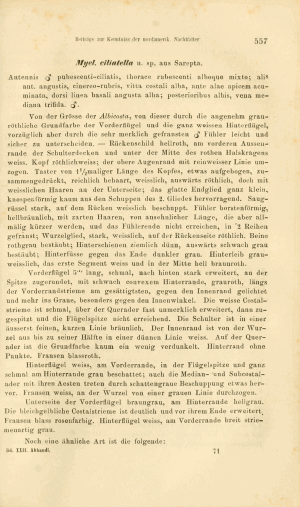

 +2Kontinente:EUAS
+2Kontinente:EUAS2. Diagnose
2.1. Erstbeschreibung
4. Weitere Informationen
4.1. Andere Kombinationen
- Myelois ciliatella Zeller, 1872 [Originalkombination]
4.2. Taxonomie
Bidzilya et al. (2020) kommen zum Schluss: "Myelois ciliatella was described from a single male from Sarepta. We studied six males and six females from South of European Russia and Kazakhstan which match externally to the photograph of holotype in all details and, hence, are conspecific with latter. The study of the genitalia of these specimens justified A. ciliatella a separate species, which genitalia differ considerably from those of A. rhodochrella. We therefore reinstate A. ciliatella as valid species: A. ciliatella (Zeller, 1872) spec. rev., stat. nov." Ihre Diagnose beginnen sie mit den Worten: "Ancylosis ciliatella is a rather variable species (Figs 78–81). The forewing is varying from pale, light brown to reddish-brown and magenta, but white costal strip is usually distinct. This forewing pattern in combination with narrow elongated forewing with distinct apical and tornal angles and long cilia on the male antennae are most constant characters for separating of A. ciliatella from related species of Ancylosis." Und dann: "Ancylosis ciliatella seems most related to Ancylosis pectinatella (Ragonot, 1887), A. yerburii (Butler, 1884) and A. labeculella (Ragonot, 1887) both in the genitalia and externally sharing long cilia on the male antennae." Die Autoren bieten eine umfassende Wiederbeschreibung der Art an.
4.3. Faunistik
Die Art wurde von Zeller (1872: 557) nach (einem?) Männchen aus Sarepta (bei Wolgograd, Russland) beschrieben. Bidzilya et al. (2020: 475) schreiben zum momentanen Kenntnisstand der Verbreitung: "The species is known with certainty from Russia (Volgograd and Astrakhan regions) and Kazakhstan (Mangistau and Turkestan regions). Records from other regions (Roesler 1973 (as A. rhodochrella)) need verification."
(Autor: Erwin Rennwald)
4.4. Literatur
- Bidzilya, O., Budashkin, Y., Slamka, F., Tsvetkov, E. & V. Yepishin (2020): Notes on taxonomy and distribution of some Palaearctic Ancylosis Zeller, 1839 (Lepidoptera: Pyralidae: Phycitinae). — Zootaxa, 4822 (4): 451–481.
- Erstbeschreibung: Zeller, P. C. (1872): Beiträge zur Kenntniss der nordamerikanischen Nachtfalter, besonders der Microlepidopteren. Erste Abtheilung. — Verhandlungen der zoologisch-botanischen Gesellschaft in Wien 22: 447–566, pl. II-III.





